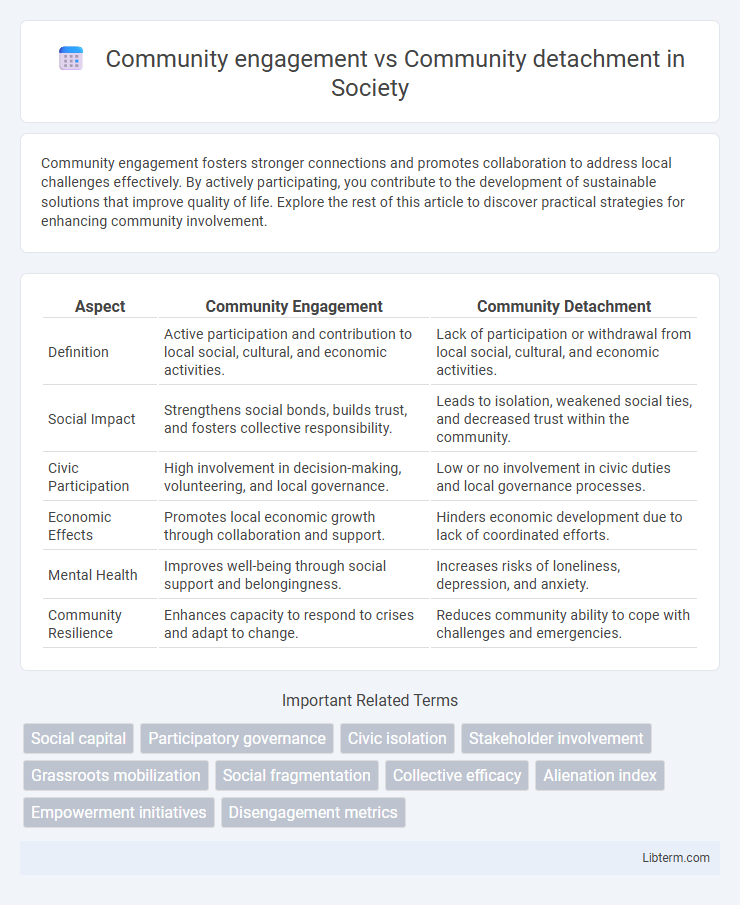Community engagement fosters stronger connections and promotes collaboration to address local challenges effectively. By actively participating, you contribute to the development of sustainable solutions that improve quality of life. Explore the rest of this article to discover practical strategies for enhancing community involvement.
Table of Comparison
| Aspect | Community Engagement | Community Detachment |
|---|---|---|
| Definition | Active participation and contribution to local social, cultural, and economic activities. | Lack of participation or withdrawal from local social, cultural, and economic activities. |
| Social Impact | Strengthens social bonds, builds trust, and fosters collective responsibility. | Leads to isolation, weakened social ties, and decreased trust within the community. |
| Civic Participation | High involvement in decision-making, volunteering, and local governance. | Low or no involvement in civic duties and local governance processes. |
| Economic Effects | Promotes local economic growth through collaboration and support. | Hinders economic development due to lack of coordinated efforts. |
| Mental Health | Improves well-being through social support and belongingness. | Increases risks of loneliness, depression, and anxiety. |
| Community Resilience | Enhances capacity to respond to crises and adapt to change. | Reduces community ability to cope with challenges and emergencies. |
Understanding Community Engagement
Community engagement involves active participation, collaboration, and shared decision-making among members to address local issues and foster social cohesion. Understanding community engagement requires recognizing its impact on building trust, empowering individuals, and enhancing resource allocation for sustainable development. In contrast, community detachment leads to isolation, reduced social capital, and weakened collective action, hindering effective problem-solving and communal growth.
Defining Community Detachment
Community detachment refers to the lack of participation, emotional connection, or sense of belonging individuals feel toward their local community, often resulting in social isolation and decreased collective well-being. It manifests through minimal involvement in neighborhood activities, low trust among residents, and weakened social networks. Understanding community detachment is essential for developing strategies to enhance social cohesion and foster active engagement.
Key Differences Between Engagement and Detachment
Community engagement involves active participation, collaboration, and shared decision-making within a group, fostering social cohesion, trust, and collective growth. In contrast, community detachment is characterized by withdrawal, lack of communication, and minimal involvement, leading to isolation, weakened social bonds, and reduced community resilience. Key differences lie in the levels of interaction, commitment to communal goals, and the impact on social infrastructure and individual well-being.
The Importance of Active Participation
Active participation in community engagement fosters stronger social bonds, enhances collaboration, and drives effective problem-solving within neighborhoods. Community detachment often leads to isolation, reduced civic responsibility, and weakened support networks, undermining collective well-being. Prioritizing active involvement encourages shared ownership of local initiatives and promotes sustainable development.
Social Impacts of Community Detachment
Community detachment leads to increased social isolation, diminished trust among residents, and weakened social networks, resulting in adverse impacts on mental health and collective well-being. Reduced participation in communal activities often correlates with higher crime rates and lower civic engagement, undermining social cohesion. Economic disparities intensify as detached communities lack the social capital critical for support systems, resource sharing, and cooperative problem-solving.
Benefits of Strong Community Connections
Strong community connections foster social support networks that enhance mental health and resilience. Engaged communities experience improved resource sharing, leading to increased economic opportunities and public safety. Active participation in local initiatives promotes a sense of belonging, reducing feelings of isolation and strengthening overall community well-being.
Barriers to Community Engagement
Barriers to community engagement often include lack of trust, limited access to resources, and inadequate communication channels, which contribute to community detachment. Socioeconomic factors such as poverty, language differences, and cultural misunderstandings further hinder participation and collaboration among community members. Overcoming these challenges requires targeted strategies that foster inclusivity, build trust, and improve accessibility to ensure effective civic involvement.
Strategies to Combat Community Detachment
Effective strategies to combat community detachment include fostering inclusive communication channels, organizing local events that encourage participation, and leveraging social media platforms to create a sense of belonging. Building partnerships with local organizations and providing opportunities for community members to contribute to decision-making processes enhance social cohesion. Regular outreach programs and transparent governance systems further bridge gaps, reducing feelings of isolation and promoting active engagement.
Measuring Community Engagement Effectiveness
Measuring community engagement effectiveness involves analyzing metrics such as participation rates, feedback quality, and social media interactions to gauge the depth of community involvement and connection. High engagement correlates with increased trust, collaboration, and positive outcomes in community-driven projects, whereas community detachment often results in low participation, apathetic feedback, and diminished social cohesion. Tools like surveys, engagement analytics platforms, and sentiment analysis provide quantitative and qualitative data essential for assessing whether initiatives foster meaningful community connections or contribute to disengagement.
Future Trends in Community Involvement
Future trends in community involvement emphasize digital platforms that enhance real-time interaction and collaborative decision-making, bridging gaps that often lead to community detachment. Increasing use of augmented reality (AR) and virtual reality (VR) tools facilitates immersive engagement, fostering deeper connections among members and local organizations. Data-driven approaches enable tailored outreach strategies, improving inclusivity and sustaining long-term community participation.
Community engagement Infographic

 libterm.com
libterm.com